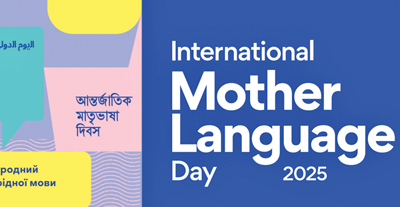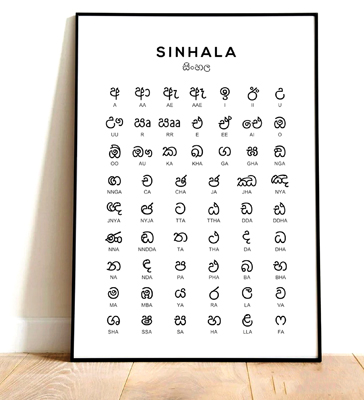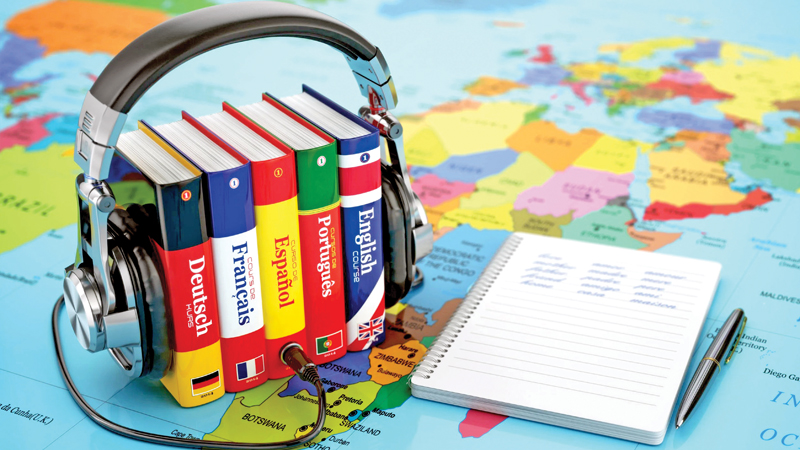 The world would indeed be a dull place if there were only one or two languages. Only a few of them have more than a million native speakers.
The world would indeed be a dull place if there were only one or two languages. Only a few of them have more than a million native speakers.
Chinese, English, French, Italian, German, Spanish, Hindi, Japanese, Russian, Arabic and Swahili (the phrase Hakuna Matata or “no problem” popularised by the Lion King movies is Swahili) can be considered as some of the leading languages. Languages are living, breathing entities that change over time. Languages evolve and take on words from other languages.
Everyone has a Mother language or native language, which we pick up very early on in life. In Sri Lanka, this would be either Sinhala or Tamil, though in some households both these languages are spoken and the children pick up both. Either way, Amma (Mother) is the first word uttered by Sri Lankan children. Lest we forget, Malay is spoken by the Malay community in Sri Lanka and the Wannila Aththo have their unique language, though it is often interspersed with Sinhala words.
Linguistic diversity
Worldwide, the equivalent for Mother or Amma is the first word spoken by children. Generally, by age 5 or 6, we become fairly fluent in our mother tongue, though reading and writing skills may take some more years to develop. Any language, whether spoken by billions or just a few, is a living treasure and a window to the world.
Languages are essential to education and sustainable development, serving as the primary means through which knowledge is transferred and cultures are preserved. With approximately 8,300 languages in the world today, many are at risk of disappearing due to globalisation and societal changes. Ensuring that education systems support the right to learn in one’s mother tongue is crucial for improving learning outcomes, as students who are taught in a language they fully understand show better comprehension, engagement, and critical thinking skills.
Multilingual education, particularly for minority and indigenous languages, not only helps learners but also fosters a deeper connection between education and culture, contributing to more inclusive and equitable societies. Some children are adept at learning two or more languages at once – this is inevitable if you live in a country such as Switzerland where French, Italian, German and English are widely spoken.
 This year, we mark the 25th anniversary of International Mother Language Day, which was originally proposed by Bangladesh. It marks a quarter-century of efforts to preserve linguistic diversity and promote mother tongues. This milestone emphasizes the importance of language preservation in safeguarding cultural heritage, improving education, and fostering more peaceful societies.
This year, we mark the 25th anniversary of International Mother Language Day, which was originally proposed by Bangladesh. It marks a quarter-century of efforts to preserve linguistic diversity and promote mother tongues. This milestone emphasizes the importance of language preservation in safeguarding cultural heritage, improving education, and fostering more peaceful societies.
International Mother Language Day, first proclaimed by UNESCO and later adopted by the UN General Assembly, underscores the role of languages in promoting inclusion and achieving Sustainable Development Goals (SDGs). Multilingual education not only promotes inclusive societies but also aids in preserving non-dominant, minority, and indigenous languages. It is a cornerstone for achieving equitable access to education and lifelong learning opportunities for all individuals.
Voices endangered
According to UNESCO, languages, with their complex implications for identity, communication, social integration, education and development, are of strategic importance for people and the planet. Yet, due to globalisation processes, they are increasingly under threat, or disappearing altogether. Sometimes Governments also force everyone to speak the country’s main language through overt or covert means. However, the speakers have resisted such efforts and revived languages such as Welsh and Gaelic.
When languages fade, so does the world’s rich tapestry of cultural diversity. Opportunities, traditions, memory, unique modes of thinking and expression — valuable resources for ensuring a better future — are also lost. But there is some hope – the language communities on the web are active and help other people to learn a language of their choice, even the more obscure ones.
But sadly, every two weeks a language disappears taking with it an entire cultural and intellectual heritage. Around 7,000 languages are still in use, though some languages are down to just one or two speakers. Many of these languages do not have a written script, further sealing their fate. However, there are several new experiments where script-less languages are getting a “makeover” from languages that have a script.
One major example is the attempt to write Indonesia’s Cia-Cia language (spoken in a few Indonesian islands) in Hangul (Korean). Proponents of Cia-Cia Hangul suggested the ease of use, as Hangul is perhaps among, or the easiest writing systems to learn.
This might also trace back to the similarities shared between Cia-Cia and Korean. Cia-Cia, for instance, has no consonant clusters, like in Korean. This makes it easier for Cia-Cia words to be split into syllable blocks, as opposed to languages that use consonant clusters.
Only a few hundred languages have genuinely been given a place in education systems and the public domain, and less than a hundred are used in the digital world. English is very dominant in the digital word, at the expense of most other languages. But this cannot be helped – English is the lingua franca of the world, though there are other languages which have more speakers overall. But it is always better to have a mix of languages – multilingual and multicultural societies exist through their languages, which transmit and preserve traditional knowledge and cultures in a sustainable way.
The International Mother Language Day was proclaimed by the General Conference of the United Nations Educational, Scientific and Cultural Organization (UNESCO) in November 1999. The UN General Assembly welcomed the proclamation of the day in its Resolution of 2002.
On May 16, 2007 the United Nations General Assembly in its Resolution A/RES/61/266 called upon Member States “to promote the preservation and protection of all languages used by peoples of the world”. By the same resolution, the General Assembly proclaimed 2008 as the International Year of Languages, to promote unity in diversity and international understanding, through multilingualism and multiculturalism and named the United Nations Educational, Scientific and Cultural Organization to serve as the lead agency for the Year.
 Today there is growing awareness that languages play a vital role in development, in ensuring cultural diversity and intercultural dialogue, but also in strengthening co-operation and attaining quality education for all, in building inclusive knowledge societies and preserving cultural heritage, and in mobilizing political will for applying the benefits of science and technology to sustainable development.
Today there is growing awareness that languages play a vital role in development, in ensuring cultural diversity and intercultural dialogue, but also in strengthening co-operation and attaining quality education for all, in building inclusive knowledge societies and preserving cultural heritage, and in mobilizing political will for applying the benefits of science and technology to sustainable development.
Moreover, the International Decade of Indigenous Languages (2022-2032) aims to ensure indigenous peoples’ right to preserve, revitalise and promote their languages. It offers an opportunity to collaborate in the areas of policy development and stimulate a global dialogue and to take necessary measures for the usage, preservation, revitalisation and promotion of indigenous languages around the world.
They are the First People. They have usually been in a given region for centuries, even thousands of years, before the arrival of the ‘Others’. But all over the world, the ‘Others’ have trampled on their rights, their lands and even their very lives. And some of them do face extinction in just a few decades, if not years. This is the story of the world’s 480 million indigenous people or First Nation people, including the Wanniyela Aththo of Sri Lanka.
There are various definitions for indigenous peoples, but this version from the United Nations is widely accepted: “Indigenous populations are composed of the existing descendants of the peoples who inhabited the present territory of a country wholly or partially at the time when persons of a different culture or ethnic origin arrived there from other parts of the world, overcame them, by conquest, settlement or other means, reduced them to a non-dominant or colonial condition; who today live more in conformity with their particular social, economic and cultural customs and traditions than with the institutions of the country of which they now form part, under a state structure which incorporates mainly national, social and cultural characteristics of other segments of the population which are predominant.” It is vital to preserve their languages and their traditions.
Languages for building bridges
This year, the main theme for the International Mother Language Day is “Languages for Peace and Harmony”. Languages are not a barrier for peace, rather they are a conduit for it. In Sri Lanka, where an ethnic conflict raged for nearly 30 years, the Government decided to teach Tamil to Sinhala speaking students and Sinhala to Tamil speaking students, with English as the link language.
Now most children can speak both languages as well as English with varying degrees of fluency. Indeed, in 15-20 years, when they become adults, everyone will be able to speak and understand the language of the “Other”, permanently ending the so-called ethnic divide.
In countries such as South Africa, which is often cited as a role model for ethnic reconciliation, the national anthem itself is sung in many languages in Afrikaans. Black South Africans, who were oppressed by the White and Afrikaans community, have no qualms singing the words that are in Afrikaans, hand on their hearts. That shows the healing power of languages.
In India, the national anthem is in Bengali, which was the mother tongue of its creator Rabindranath Tagore, who also wrote the national anthem of Bangladesh, where Bengali is the main language.
In Sri Lanka, the national anthem is now sung in Tamil too at State functions, after a previous regime “banned’ it in an attempt to appease certain extremist and racist elements. Muruggapillai Nallathambi translated the national anthem, “Namo Namo Matha” into Tamil. Nallathambi was a Tamil poet, scholar, and teacher who was an expert of both Sinhala and Tamil languages. It is an identical word to word translation with the same musical score.
Art of translating
This also brings us to the power of translations in cutting across artificial boundaries imposed by languages. It would be pathetic if we cannot understand what another person is saying in another language. One way is learning that language, but this is not something everyone can do and besides, it would take years to develop native level language skills. This is where translators and translations step in.
Just the other day, I was watching the hit Korean movie Train to Busan on Blu Ray. Of course, I did not understand a word being spoken by the characters, but I followed the action thanks to the subtitles. In other words, someone helped me to understand what was going on – that is the power of translation. Translations come in two flavours – translating the written word is the first one.
When someone translates a book written in Sinhala to English that is a translation of the written word. It is often impossible to translate word to word – there are plays on words, idioms, nuances and expressions that may not lend themselves well to direct translation.
The job of the translator is to convey the original writer’s ideas in the other language to the best of his or her ability without distorting the meaning in any way. The other flavour is even more challenging. It is called interpreting – one has to translate the words of a live speaker in real time. The interpreter has to think on his or her feet as the words flow in the native language of the speaker and quickly translate it for the benefit of listeners.
One exciting and somewhat worrying possibility is that Artificial Intelligence will eventually be able to do “on the fly” translations and even eliminate the need to learn new languages, because it will interpret a conversation in two different languages in real time. But whatever AI does, human languages will always have a permanent place in our hearts and minds.
IMLD events at Independence Square
The main International Mother Language Day ceremony will be held on February 21 from 8.30 a.m. at the Independence Square in Colombo under the patronage of Prime Minister Dr. Harini Amarasuriya. The event, organised by the Bangladesh High Commission in partnership with the Ministry of Education, United Nations and the Sri Lanka Scout Association, will be held under the theme “Languages for Peace and Harmony”. The day’s program will include an awards ceremony for the winners of art, creative writing and video competitions on this theme. There will also be a cultural performance by schoolchildren.




